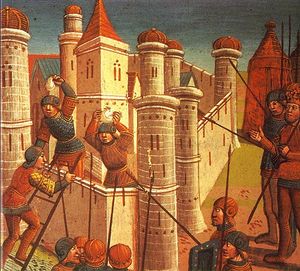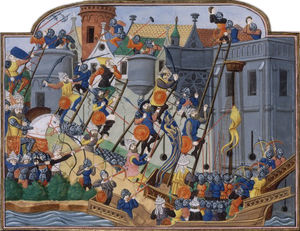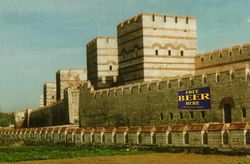Fall of Constantinople
| Byzantine–Ottoman Wars | |||||||
|---|---|---|---|---|---|---|---|
 Stay out of our clubhouse, or we'll throw spears at you! |
|||||||
|
|||||||
| Belligerents | |||||||
| Byzantine Empire | Ottoman Empire | ||||||
| Commanders and leaders | |||||||
| Constantine XI | Mehmed II | ||||||
| Strength | |||||||
| 7000 | 80,000–200,000 | ||||||
| Casualties and losses | |||||||
| 4000 Constantine XI his dog | 50000 Mongols | ||||||
“It had to fall; it was at the edge of the ancient map of the world”
– Kelly Bundy on Constantinople
The Fall of Constantinople (not Istanbul) refers to the battle where the Byzantine Empire lost the city of Constantinople and all of their shiny trinkets and yellow rocks to the Ottoman Empire, bringing an end to the millennium-or-so-long Byzantine rule of the area, and also made for a great movie plot line and a successful line of action figures.[1] The Ottomans rebuilt the city after the siege and invited the original denizens to move back, but they declined the offer, the most likely reason being either that they did not like the Turkish curtains that the Ottomans installed or they thought the Ottomans smelled bad. All of the Greek scholars who once made their home in Constantinople moved to Italy, taking their vast book collection and recipe for flat bread[2] – the predecessor to pizza and all of its deliciousness – with them. Eventually, people did come back after Mehmed's publicity stunt.
State of the Byzantine Empire
In the millennium-or-so-long existence of the Byzantine Empire (give or take a few days), it was besieged many many many many times, but was sacked only once, during the Fourth Crusade in 1204.[3] The crusaders did not intend to conquer Byzantium in the beginning, but due to a low war budget and incompetence toward the pope, they had no choice but to plunder the capital's vaults and take all their shiny things. After Constantinople was captured, they established a "Latin[4] Empire" in the city, and the Byzantine Empire was split into several successor states.[5] The Latin Empire tried to make the Byzantines rub themselves with Vaseline and dump spicy sauce on their food, much to the disdain of the Byzantine Greeks, and the Latins became the (second) most hated establishment ever.[6] The Greek successor states waged war with the Latin Empire to retake Constantinople, but waged slap fights against each other for the throne, as there could be only one. In the end, the Nicaeans retook Constantinople in 1261. Within the next two centuries, the heavily-weakened Byzantine Empire now up against the Latins, Serbia, Bulgaria, a whole bunch of pissed-off Slavs, and, most importantly of all, the Ottoman Empire and there was also a couple of drunk Irish guys but that wasn't important.
Preparations

As Ottoman Sultan Mehmed II approached Constantinople, he remembered that his grandpa, Bayezid I, had built a tiny, cozy little shack called Anadolu Hisarı (Turkish for "Little house on the prairie") on the Asian side of the Bosphorus Strait. He and his army went and gathered a large cache of food, ammunition, and candy from the shack and headed over to Europe. There, Mehmed built another cozy little shack called Rumeli Hisarı (Turkish for "Little house perched strategically atop a hill overlooking Constantinople that also has a great view of the beach"), which was built just a mile or so away from the walls of Constantinople. They had a few beers there, played a game of cards, and started to plan the upcoming siege against the city on a cocktail napkin.
Meanwhile, the Byzantines appealed to Western Europe for help, but this call fell upon deaf ears. Ever since the mass excommunication of Orthodox Christians by the Roman Catholic church, the West wanted nothing to do with the East, as they say the orthodox Christians are "stupid, stinky, promiscuous, and like to fornicate with their mothers[citation needed]". Emperor John VIII Palaiologos repeatedly tried to negotiate with Pope Eugene IV for a union between Eastern and Western Europe. Eugene repeatedly refused, and John kept calling him again and again. This annoyed Eugene so much that he threw his phone out the window and stopped returning John's calls, and with that, the union failed. After the Byzantine people heard of John's failure to enlist the aid of the pope, they poked out his eyes with a stick, deposed him, threw his body in the water, and installed Constantine XI Palaiologos, the empire's most forlorn emperor.
The Byzantine army totaled around 7000 men, 2000 of whom were foreign mercenaries. The mercenaries themselves were greatly lethargic and spent most of their time in the pub. The Byzantines also had about twenty kilometers of wall that were entirely self-sufficient. (They could practically repair themselves over a span of time.)[7]) As a final line of defense, the walls had giant signs on the outside of it that said GO AWAY in bold letters. The Ottomans, on the other hand, had a far larger force. Estimates for the army's size range from 80,000 to as far as the eye can see. Mehmed also had his engineers build a vast fleet to bombard the city by sea, and a fun-time boat for the victory party afterwards. Contemporary estimates for the strength of the Ottoman fleet range from a hundred to a thousand.
On April 5, the sultan approached the walls of the city, knocked on their door, and gave the denizens one last chance to surrender willingly. The Byzantines bluntly refused, and started to throw animals at him in order to make him go away. Constantine was on top of the wall at that time, and told Mehmed to "go fuck himself", because he was too terrified to fuck him personally. [Citation not needed at all; thank you very much] Infuriated, the sultan went back onto the hill looking over the city and ordered his men to build a giant foundry so they could forge medium-sized cannons to be used on the walls. By next morning, the foundry was built, and they had already produced 100 cannons, the largest of which was pulled by a dozen donkeys. Mehmed also made a special cannonball that would be fired first in order to get back for the things Constantine said to him; it was special because on it was written "Fuck me? No, no, no. Fuck you!"
Siege of the city

On the quiet morning of April 6, a mysterious figure named Urban "the Burnin' Suburban Turban" McGee[8] arrived in the area. Originally from Hungary, he was a cannon-smith, doodler, and antique collector who traveled abroad selling his schematics and cartoon drawings to anyone who was interested. Both Constantine XI and Mehmed II approached Urban, who was standing in a makeshift auction house between the walls of Constantinople and the Ottoman army, to try and hire him. The Byzantines offered him God's blessing and would place his name among the saints. The Ottomans offered him a hundred thousand shiny gold coins, a mountain of pretty jewels, a harem of five hundred women, a ten-year subscription to Playboy, a gold-plated chariot and a pony.[9]
Predictably, Urban sided with the Ottomans, and as a display of gratitude toward the sultan, he constructed the largest cannon ever made; it was 27 feet in length, 2.5 feet in diameter, and could fire a 1200-pound cannonball over a mile. However, this cannon had a special, magical property that enabled it to fire eurgs, which were the only things that could inflict damage to the walls of Constantinople, as they were impervious to both grues and anti-grues. They named the cannon Big Bertha. Unfortunately, the cannon had a few drawbacks: it was highly inaccurate, it could not hit the broad side of a barn, it took forever to reload, and many a man died trying to load a single eurg into the cannon. Despite these drawbacks, the eurgs that the cannon fired caused massive damage to the wall, but due to the slow reload rate, the wall would regenerate and repair most of the damage inflicted upon it.
Meanwhile, the sultan's fleet could not enter the Golden Horn due to a giant stick covered in bees that the Byzantines had lain across the entrance. Nothing could get into the Golden Horn, but on April 20, a giant whale managed to slip under the stick without any resistance, causing major embarrassment for the sultan. To circumvent the stick, Mehmed ordered that a giant conveyor made of greased logs be constructed so that he could roll his ships into the Golden Horn. To expedite the construction, he acquired the assistance of a traveling gypsy circus which just happened to be in the area at the time, and in just two days, the Ottomans had rolled all of their ships across and into the horn. They also killed the whale that managed to swim under the stick. However, this is debated, as the Ottoman officials claim the whale killed itself.[10]
The Ottomans also made numerous attempts at pping the walls. These attacks failed, as the Byzantines were warned of the attacks by a man who could talk to moles. They dug tunnels to counter the tunnels being dug by the Ottomans, and poured concrete into the holes killing the attackers.
In the middle of the battle, Mehmed approached the walls of the city and offered to raise the siege in exchange for an astronomical tribute that he knew the citizens were unable to pay: he demanded that they bake a pie (a cherry pie to be exact) approximately the size of a football field. When this was declined and when the people started to throw animals at him, he had no choice but to overpower the walls by force.
On the fateful morning of May 9, and with Mehmed's patience at an end, the final attack began. He first sent conscripts armed with pointed sticks and giant pieces of bark for shields, and wore shirts that said "Shoot at me". These were meant only to make the Byzantines waste their energy and arrows, but the Byzantines threw pears, apples, and many other assorted fruits at the attackers, which proved just as effective as any arrow. He then sent soldiers to pile the dead against the wall so they could climb over it. The Byzantines thwarted this by setting the body piles that were being made next to the walls on fire. They then sent out dogs to eat the barbecued human meat.
At noon of the same day, Mehmed noticed that the gate on the north side of the wall was left open the entire siege, but it was obscured due to debris left by the cannon fire.[11] Realizing this, and after punching himself in the face several times while shouting "I am an idiot" for not realizing it sooner, Mehmed ordered his entire army to enter through the open gate. Constantine XI, in a last-ditch effort, exited out of his palace, sword in-hand, and engaged in combat against the Ottoman army where he fell in battle after pwning many turkeys.
Aftermath

Far from being the grand and magnificent city it once was, Constantinople was ravaged heavily by the bubonic plague and especially from being sacked during the Fourth Crusade just two centuries earlier. By the 5th century, Constantinople was nothing more than a few walled villages separated by large expanses of fields, and most of the fields were being eaten away by rabbits that were now running amok in the city. When the Ottoman army made it into the walls, they captured, killed, cooked, and ate all the rabbits, and as an expression of gratitude, many of the villages gave themselves up willingly to the invaders.
Since he was the new ruler of Constantinople, Mehmed II believed that he was the new Roman Emperor. He named himself "Kayser-i Rum", Turkish for "Roman Emperor Am I", but due to trademark disputes, he was nicknamed simply as "the Conqueror". Constantinople became the new capitol of the Ottoman Empire, but they renamed the city "Istanbul", as they believed it was more catchy and had more zing than "Constantinople". Even though the Greek Orthodox Church remained intact, Hagia Sophia was converted into a mosque, the Christian murals painted over with Islamic imagery, the bibles replaced with anthologies of Al-Fiaald, the Muslim cat who covets lasagna and detests false prophets.
Many of the inhabitants fled the city and sailed to the Latin West, bringing with them Greek knowledge, literature, philosophy, and the recipe for flat bread. Within the next hundred years, the flat bread evolved and became the delicacy known as the sushi pizza.
See also
Notes
- ↑ The most popular item was Mehmed II with light-up eyes.
- ↑ Not tortillas.
- ↑ Their self-esteem had been bruised ever since then.
- ↑ even though everyone spoke Greek
- ↑ The number of successor states is somewhere in the range of 6 to 324.
- ↑ seconded by the Bush administration
- ↑ from two minutes to ninety days
- ↑ O' Burnin' Suburban Turban McGee, won't you come out and play with me?
- ↑ PONIES!
- ↑ No, really!
- ↑ The gate was left open so the emperor's dog could go potty.


